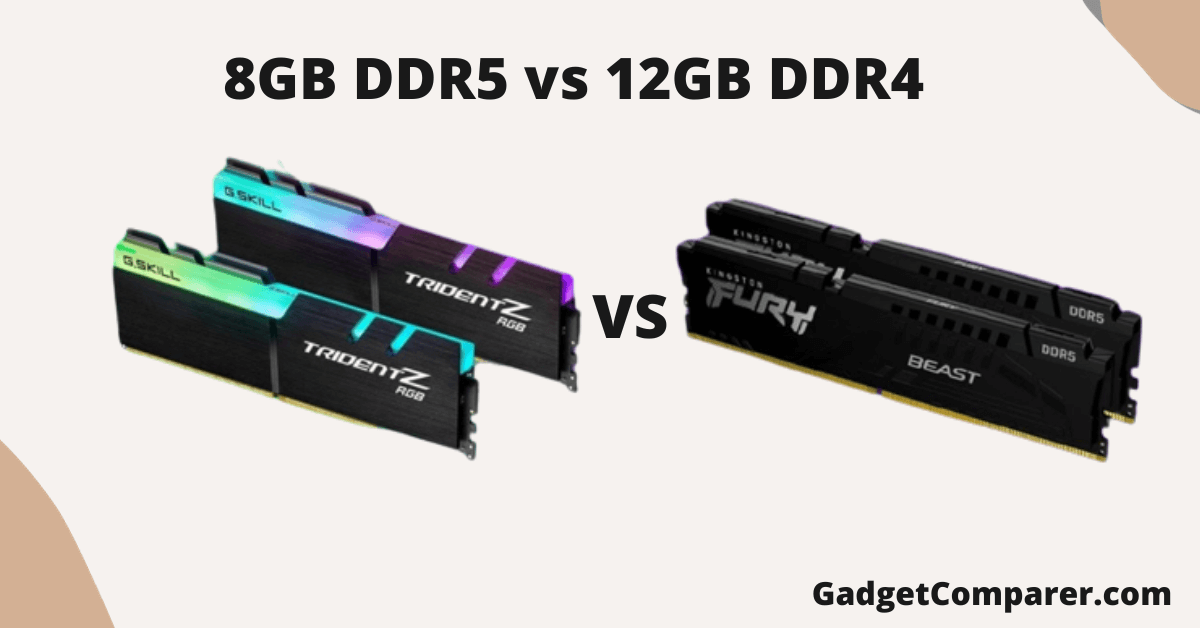When comparing 8GB DDR5 RAM and 12GB DDR4 RAM, it is important to note that these two types of memory have different purposes and are used in different types of devices.
DDR5 is primarily used in graphics cards (GPUs), while DDR4 is used in a variety of devices including laptops, desktops, and servers. Below is a detailed comparison based on several factors.
Also read,8GB DDR5 vs 16GB DDR4
8GB DDR5 vs 12GB DDR4
Performance
DDR5 generally offers higher bandwidth and faster data transfer rates compared to DDR4. This makes DDR5 well-suited for graphics-intensive tasks, including gaming and video editing. In games, especially at higher resolutions and settings, a graphics card with 8GB DDR5 can deliver smoother performance compared to a system with 12GB DDR4 RAM.
Usage
DDR5 is designed specifically for graphics memory. Used in dedicated graphics cards where high-speed memory is essential to handle large textures and complex calculations.
On the other hand, DDR4 is used as system memory in various devices such as PCs, laptops, and servers. DDR4’s versatility makes it suitable for a variety of applications, not just graphics-intensive tasks.
Volume
In this specific comparison, the DDR4 configuration has more memory (12GB) compared to the DDR5 configuration (8GB). Tasks involving large data sets, multitasking, and running memory-intensive applications benefit from more memory. For tasks that require significant system memory, the 12GB DDR4 configuration is more beneficial.
Future compatibility
DDR5 is a new technology, and as it becomes more widely adopted, future graphics cards and systems will likely utilize DDR5 memory. Choosing DDR5 provides better future compatibility and ensures your system can handle future software and games more efficiently.
Expense
Currently, DDR4 memory modules are generally cheaper than DDR5 modules. If cost is a factor, choosing a system with 12GB DDR4 RAM may be a more budget-friendly option.
Power Efficiency
DDR5 memory modules are designed to be more power-efficient than DDR4 modules. This improved energy efficiency can result in longer battery life in laptops and lower power consumption in desktop systems.
Which is better 8GB DDR5 vs 12GB DDR4?
If you’re building a gaming PC or a system that focuses primarily on graphics-intensive tasks, an 8GB DDR5 configuration may provide better performance.
However, if you need more overall system memory for multitasking, running memory-intensive applications, or future-proofing your system, the 12GB DDR4 configuration will be a better choice.
Ultimately, the best choice will depend on your specific use case, budget, and future upgrade considerations.
FAQs
What are the main differences between 8GB DDR5 and 12GB DDR4 RAM?
The biggest difference lies in technology and purpose. DDR5 is the latest generation of memory primarily used in graphics cards (GPUs) to quickly and efficiently process graphics-related tasks.
On the other hand, DDR4 is an older generation memory used in various devices such as PCs, laptops, and servers, and serves as system memory for general computing tasks.
Which provides better performance for gaming and graphics-intensive tasks: 8GB DDR5 or 12GB DDR4?
For gaming and graphics-intensive tasks, 8GB DDR5 generally provides better performance due to its higher bandwidth and faster data transfer speeds. It is specially optimized for graphics-related tasks, making it ideal for games and applications that require significant graphics processing power.
Will having more memory (12GB) in DDR4 offset the performance difference compared to 8GB DDR5 in gaming scenarios?
Having more memory can help you multitask and run memory-intensive applications. However, when it comes to gaming performance and graphics-related tasks, DDR5’s higher bandwidth and speed often have a greater impact. For pure gaming purposes, faster DDR5 can provide a smoother experience, especially in graphics-intensive games.
Is DDR5 RAM compatible with regular PCs and laptops, or only graphics cards (GPUs)?
DDR5 RAM is designed specifically for graphics cards (GPUs) and is not used as system memory in standard PCs and laptops. It serves as dedicated memory to efficiently process graphics-related tasks.
Which option is more cost-effective: choosing an 8GB DDR5 or 12GB DDR4 system?
Currently, DDR4 memory modules are generally cheaper than DDR5 modules. If cost is a factor and you need more overall system memory, choosing a system with 12GB DDR4 RAM may be a more cost-effective choice.
Is DDR5 technology more power-efficient than DDR4?
Yes, DDR5 memory modules are designed to be more power-efficient than DDR4 modules. This improved power efficiency can extend battery life in laptops and reduce power consumption in desktop systems, contributing to overall energy savings.
Which option offers better compatibility and performance for future software and games (8GB DDR5 or 12GB DDR4)?
DDR5 is a new technology and is expected to be more relevant to future software, games, and hardware. Choosing DDR5 can provide better compatibility and performance in the future. Especially since more applications and games are optimized for the higher speeds and bandwidth provided by DDR5 memory.
Can DDR5 be used as system memory (RAM) on a PC or laptop like DDR4? Or can it only be used on graphics cards?
DDR5 is mainly used in graphics cards (GPUs) for dedicated graphics memory. It is not used as system memory (RAM) in typical PCs or laptops. DDR4 and its predecessors remain the standard for system memory in most computing devices.**




